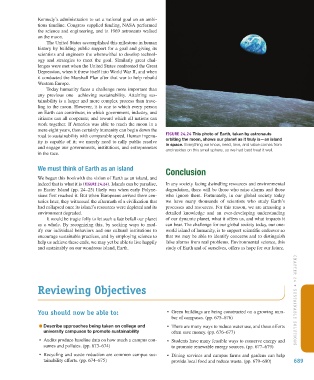Page 690 - Environment: The Science Behind the Stories
P. 690
Kennedy’s administration to set a national goal on an ambi-
tious timeline. Congress supplied funding, NASA performed
the science and engineering, and in 1969 astronauts walked
on the moon.
The United States accomplished this milestone in human
history by building public support for a goal and giving its
scientists and engineers the wherewithal to develop technol-
ogy and strategies to meet the goal. Similarly great chal-
lenges were met when the United States confronted the Great
Depression, when it threw itself into World War II, and when
it conducted the Marshall Plan after that war to help rebuild
Western Europe.
Today humanity faces a challenge more important than
any previous one—achieving sustainability. Attaining sus-
tainability is a larger and more complex process than trave-
ling to the moon. However, it is one to which every person
on Earth can contribute; in which government, industry, and
citizens can all cooperate; and toward which all nations can
work together. If America was able to reach the moon in a
mere eight years, then certainly humanity can begin down the
road to sustainability with comparable speed. Human ingenu- Figure 24.24 This photo of Earth, taken by astronauts
ity is capable of it; we merely need to rally public resolve orbiting the moon, shows our planet as it truly is—an island
in space. Everything we know, need, love, and value comes from
and engage our governments, institutions, and entrepreneurs and resides on this small sphere, so we had best treat it well.
in the race.
We must think of Earth as an island Conclusion
We began this bookwith the vision of Earth as an island, and
indeed that is what it is (Figure 24.24). Islands can be paradise, In any society facing dwindling resources and environmental
as Easter Island (pp. 24–25) likely was when early Polyne- degradation, there will be those who raise alarms and those
sians first reached it. But when Europeans arrived there cen- who ignore them. Fortunately, in our global society today
turies later, they witnessed the aftermath of a civilization that we have many thousands of scientists who study Earth’s
had collapsed once its island’s resources were depleted and its processes and resources. For this reason, we are amassing a
environment degraded. detailed knowledge and an ever-developing understanding
It would be tragic folly to let such a fate befall our planet of our dynamic planet, what it offers us, and what impacts it
as a whole. By recognizing this, by seeking ways to mod- can bear. The challenge for our global society today, our one-
ify our individual behaviors and our cultural institutions to world island of humanity, is to support scientific endeavor so
encourage sustainable practices, and by employing science to that we may be able to identify concerns and to distinguish
help us achieve these ends, we may yet be able to live happily false alarms from real problems. Environmental science, this
and sustainably on our wondrous island, Earth. study of Earth and of ourselves, offers us hope for our future.
reviewing objectives
you should now be able to: • Green buildings are being constructed on a growing num- CHAPTER 24 • Su STA in A bl E Sol u T i on S
ber of campuses. (pp. 675–676)
Describe approaches being taken on college and • There are many ways to reduce water use, and these efforts
university campuses to promote sustainability often save money. (pp. 676–677)
• Audits produce baseline data on how much a campus con- • Students have many feasible ways to conserve energy and
sumes and pollutes. (pp. 673–674) to promote renewable energy sources. (pp. 677–679)
• Recycling and waste reduction are common campus sus- • Dining services and campus farms and gardens can help
tainability efforts. (pp. 674–675) provide local food and reduce waste. (pp. 679–680) 689
M24_WITH7428_05_SE_C24.indd 689 13/12/14 10:40 AM

